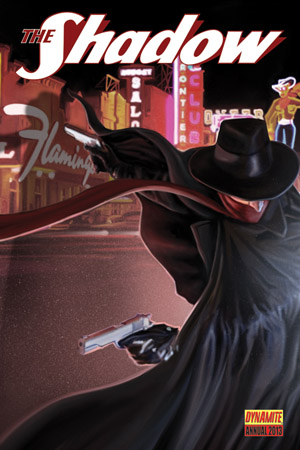This week I only got four books: three of the Villains Month issues and one Annual for The Shadow. I chatted with Stu at Emerald City Comics on Wednesday when I picked up my books, and he pointed out that my hypothesis that DC was trying to increase sales with the Villains Month issues was flawed. I reasoned that these issues are being dropped into the best-selling titles so that subscribers would pick up more issues, boosting sales by replacing unpopular books with ersatz popular books for a month. This cannot be, Stu explained, because DC did not manage to get enough of the Villains Month titles printed: the paper for the lenticular covers was in short supply, so retailers across the country have not been able to fill their full orders with 3D-cover issues. In fact, Emerald City Comics is offering full-value trade for Villains Month issues that are in like-new condition. DC may not make that much extra on this promotion, but these issues have high potential as collectors items.
Again, stars out of five.
The Shadow Annual 2013, Parks, Evely, Miwa, Steen, Cover: Worley. *
I thought it was too soon to get another Shadow annual, but looking back, the last annual was indeed September 2012. There was a Shadow Special in December 2012 that was so good I still remember it quite clearly. Alas, this year’s annual is not so effective. The art is OK, but never quite enhances the story. The figures are very wooden and the faces do not come alive. The story is a relatively straightforward one of love lost and youth misspent, a typical tale for the Shadow with no surprises. It seems to me that The Shadow could make great use of the Las Vegas setting, but the city is used in a very generic way. Even his trademark laugh is missing from most of this lifeless installment.

A non-3D view of The Penguin #1. If you cross your eyes and squint for long enough you might be able to make it move…
The Penguin #1 (Batman #23.3), Tieri, Duce, Dalhouse, Esposito, Cover: Fabok & Fairbairn. ***
Another Villain issue. Sigh. I want my regular superhero stories back. This story manages to have a reasonable narrative, fitting to the Penguin, but it falls into the shortcut storytelling trap of introducing characters simply to kill them off quickly… five times. Plus, one of the victims is essentially a woman in a refrigerator: Miss Collins has no lines and is a beheaded corpse 22 frames and four pages after she is introduced. Finally, I don’t think I’d ever watch a news conference in Gotham, because it seems to often end in graphic suicide.
Ra’s Al Ghul and the League of Shadows #1 (Batman and Robin #23.3), Tynion IV, Haun, Rausch, Lanham, Cover by: Gleason, Gray, and Kalisz. ****
This issue is notable because it has the longest title of the Villains Month 52. Plus, it’s pretty good. It uses the same flashback-heavy plot device Tynion IV used in last week’s Court of Owls, but to much better effect. The flashbacks show the process by which Ra’s built his edifice, tying together the frame-story and the long-view into a single narrative that illustrates his brilliance, arrogance, and purpose. I liked the connections to the Batman Inc. storyline, but it would have been nice for some editorial call-outs to specific issues. Those cross-references may seem trite, but they make it possible for folks to hunt down the longer storylines if they wish to fill in the gaps. Plus they make my nostalgia-sense tingle. I wish more of the Villains Month issues could be like this.

You’re really not missing something, viewing this cover in 2D. The bloody scratches across the middle obscure most of the art and are positioned so far out from the page that I have to hold it at arm’s length to get the 3D effect.
Cheetah #1 (Wonder Woman #23.1), Ostrander, Ibanez, Quintana, Lanham, Cover by: Ibanez. **
I seriously considered Emerald City’s offer to exchange issues for this one. It’s bad. It looks especially bad in comparison to the ongoing Wonder Woman series it replaces; Azzarello and Chiang have set the bar high here. This story is, again, pedestrian. Several characters are introduced only so they can be immediately killed off (The entire Minerva Family!), and the plot holes are huge and troubling. Here are the two most glaring, in my opinion:
1) On page 6, Wonder Woman is stabbed in the heart with the God-Slayer knife and turns into a cheetah-deer-hybrid killing machine, but we never see what happens afterwards. Does she stay cheetah-deer-killer? Is this whole scene a dream? If not, when did it happen? How does this episode advance the plot? Why does Wonder Woman get deer antlers when she transforms, but not Barbara Minerva (the titular Cheetah)?
2) Why on earth would A.R.G.U.S., the DC version of Marvel’s S.H.I.E.L.D., allow a woman with a background in a child-killing hunting-goddess cult to become the Curator of Mystical Artifacts? I mean, they must be able to do deep background checks, right? Would you want someone to have access to an object called “The God-Slayer Knife” if you weren’t sure she wouldn’t use it to become a half-cheetah killing machine? Perhaps.
At least the art is good, with dynamic figure drawing and emotionally effective faces.



Wonderful blog post. This is absolute magic from you!
I have never seen a more wonderful post than this one.
You’ve really made my day today with this. I hope you keep this up!
제이나인 필리핀 카지노
제이나인 먹튀 링크
제이나인 보라카이 카지노
제이나인 세부 카지노
제이나인 에볼루션 카지노 가입
https://www.j9korea.com